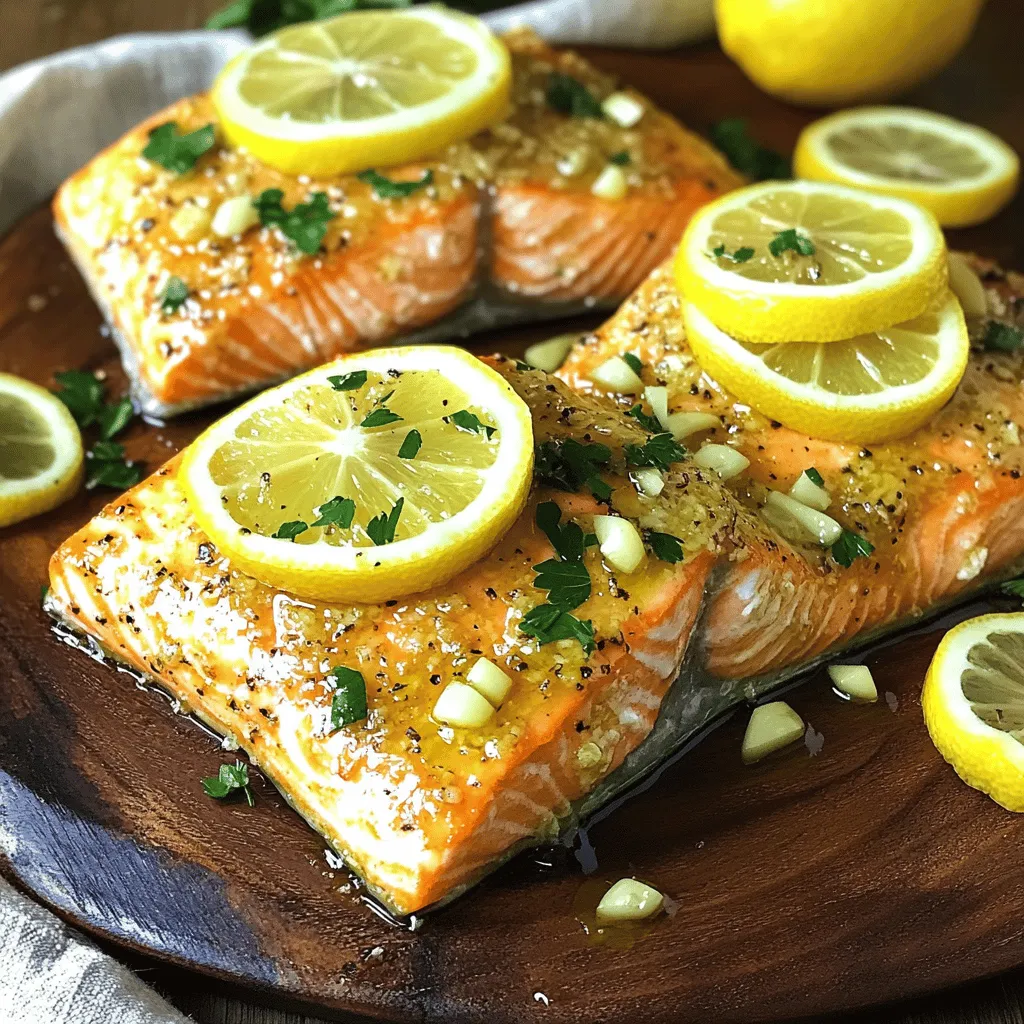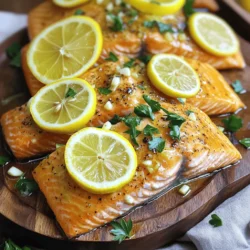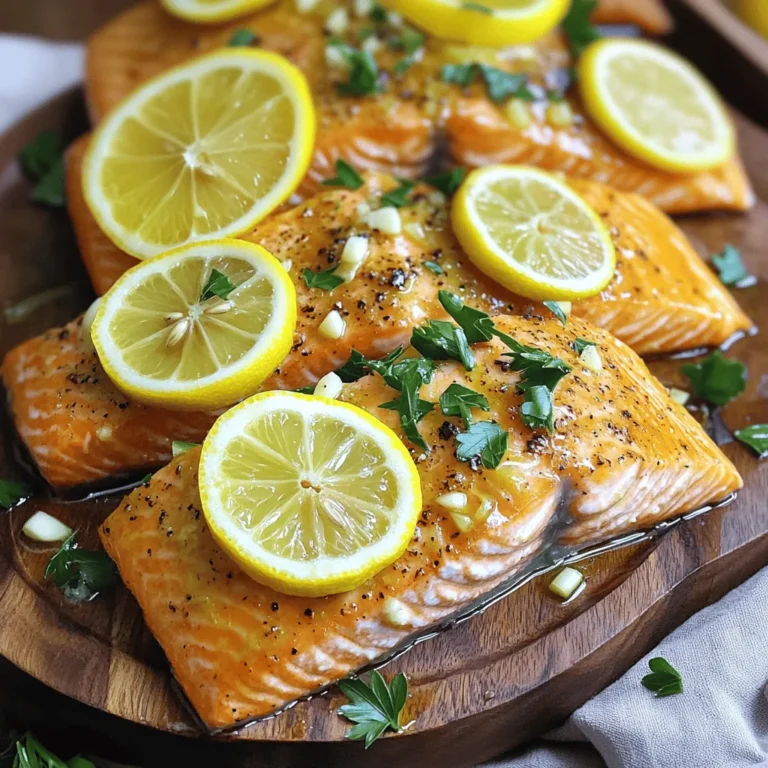Are you ready to elevate your dinner game? Lemon Garlic Roasted Salmon is a dish that bursts with fresh flavors and is simple to prepare. In this article, I’ll share the exact ingredients, step-by-step instructions, and clever tips that will ensure your salmon turns out perfectly every time. Whether you’re an experienced chef or a beginner, this recipe will impress everyone at your table. Let’s dive in and get cooking!
Ingredients
Detailed Ingredient List
To make lemon garlic roasted salmon, gather these ingredients:
– 4 salmon fillets (6 ounces each)
– 3 tablespoons olive oil
– 4 cloves garlic, minced
– Juice of 2 lemons
– Zest of 1 lemon
– 1 teaspoon fresh rosemary, chopped (or ½ teaspoon dried)
– Salt and pepper to taste
– Lemon slices for garnish
– Fresh parsley, chopped for garnish
Ingredient Substitutions
You can swap ingredients based on what you have. Try these:
– Use avocado oil instead of olive oil for a different taste.
– If you lack fresh garlic, garlic powder works too. Use ½ teaspoon.
– No fresh rosemary? Dried thyme or dill can add nice flavor.
– For a twist, swap lemon for lime or orange juice.
Tips for Choosing Fresh Salmon
When picking salmon, look for these signs:
– Choose fillets that are bright and shiny.
– Fresh salmon should smell like the ocean, not fishy.
– The flesh should be firm and spring back when pressed.
– Look for vibrant color; deep pink is often best.
– If possible, buy wild-caught salmon for better flavor and health.
This lemon garlic roasted salmon recipe is a simple way to impress your family or guests. Check the Full Recipe for step-by-step guidance.
Step-by-Step Instructions
Preparation Steps
To start, gather all your ingredients. You will need four salmon fillets, olive oil, garlic, lemons, rosemary, salt, and pepper. Preheat your oven to 400°F (200°C). This step is key to getting crispy skin. In a small bowl, mix the olive oil, minced garlic, lemon juice, lemon zest, chopped rosemary, salt, and pepper. This blend creates a tasty marinade.
Now, take a large baking sheet and line it with parchment paper or foil. This makes cleanup easier. Set your salmon fillets on the sheet. Brush the olive oil mixture on each fillet. Make sure to coat them well for maximum flavor.
For a bright touch, add lemon slices on top of each fillet. This will add more flavor and make your dish look pretty.
Cooking Process
Once your salmon is ready, place it in the preheated oven. Roast them for about 12 to 15 minutes. The time may vary based on the thickness of your fillets. Keep an eye on them. The salmon should flake easily when done. If it does, it’s cooked through.
When you take them out, let them rest for a couple of minutes. This lets the juices settle. Just before serving, sprinkle fresh parsley on top. It adds a nice pop of color.
Tips for Checking Doneness
To check if your salmon is done, use a fork to gently flake the thickest part. If it flakes easily, it’s ready. You can also check the internal temperature. It should reach 145°F (63°C) for safe eating. If you prefer a softer texture, you can take it out a bit earlier. Enjoy your Lemon Garlic Roasted Salmon with confidence!
For the full recipe, visit the provided link.
Tips & Tricks
How to Enhance Flavor
To boost the taste of your Lemon Garlic Roasted Salmon, use fresh herbs. Fresh rosemary adds a great touch. You can also try dill or thyme for a different flavor. If you love spice, add a pinch of red pepper flakes. These will give your salmon a nice kick. For an extra zing, drizzle some balsamic reduction over the cooked salmon. This adds depth and sweetness.
Cooking Equipment Recommendations
You’ll need a few key tools to make this dish shine. A good baking sheet lined with parchment paper is essential. It helps your salmon cook evenly and makes cleanup easy. A whisk is useful for mixing the marinade. A brush also helps spread the marinade evenly over the salmon. Lastly, use a fork to check if your salmon is cooked right. It should flake easily.
Common Mistakes to Avoid
Many cooks make the same mistakes when roasting salmon. One big mistake is overcooking it. Salmon cooks fast, so keep an eye on it. If it flakes easily with a fork, it’s done. Another mistake is not marinating long enough. Letting the salmon sit in the marinade for at least 15 minutes enhances the flavor. Lastly, don’t skip the lemon slices on top. They add moisture and a fresh taste. Follow these tips for a perfect meal every time. For more details, check the Full Recipe.

Variations
Different Marinades to Try
You can change the flavor of your lemon garlic roasted salmon with different marinades. A honey mustard marinade adds sweetness. Mix two tablespoons of honey with one tablespoon of Dijon mustard. A soy sauce marinade gives a savory twist. Combine three tablespoons of soy sauce with the juice of one lime. Try a spicy marinade by adding chili paste to your olive oil mixture. Feel free to explore flavors that excite you!
Alternative Cooking Methods (Grilling, Pan-Searing)
You can also cook salmon in ways other than roasting. Grilling gives a smoky flavor. Preheat your grill to medium heat. Oil the grill grates to prevent sticking. Cook the salmon skin side down for about six to eight minutes. Flip it carefully and grill for another four to five minutes. Pan-searing is another great option. Heat olive oil in a skillet over medium-high heat. Cook the salmon for about six minutes on each side. Both methods create a delicious crust.
Pairing Suggestions (Sides and Sauces)
Pair your lemon garlic roasted salmon with easy sides. Roasted vegetables, like asparagus or broccoli, complement the dish well. A fresh green salad with lemon vinaigrette adds a nice crunch. For sauces, a citrus salsa brings brightness. Mix diced tomatoes, onion, cilantro, and lime juice for a fresh topping. You could also serve a creamy dill sauce for a rich taste. These pairings enhance the meal and balance flavors beautifully.
Storage Info
How to Store Leftovers
After enjoying your lemon garlic roasted salmon, let any leftovers cool. Wrap them well in plastic wrap or place them in an airtight container. Store the salmon in the fridge for up to three days. Keeping it in a good container helps keep the flavor and texture. You can also add a slice of lemon on top for extra freshness.
Reheating Instructions
To reheat your salmon, preheat the oven to 350°F (175°C). Place the salmon on a baking sheet lined with foil. Cover it loosely with more foil to keep it moist. Heat for about 10 to 15 minutes, or until warmed through. You can also use a microwave, but it may dry out the fish. If using a microwave, heat in short bursts on medium power.
Freezing Salmon Fillets
If you want to save salmon for later, freezing is a great option. Wrap the cooled fillets tightly in plastic wrap, then place them in a freezer bag. Remove as much air as possible to prevent freezer burn. You can freeze the salmon for up to three months. When ready to use, thaw it in the fridge overnight before reheating. For the best taste, enjoy it sooner rather than later.
FAQs
What can I serve with Lemon Garlic Roasted Salmon?
You can serve many tasty sides with lemon garlic roasted salmon. Here are some ideas:
– Roasted vegetables, like carrots and broccoli
– A fresh green salad with lemon vinaigrette
– Quinoa or rice for added texture
– Mashed potatoes or baked potatoes for comfort
– Steamed asparagus or green beans for crunch
These sides will enhance the meal and add color to your plate.
How long does it take to cook salmon at 400°F?
Cooking salmon at 400°F takes about 12 to 15 minutes. The exact time may depend on the thickness of the fillets. To check if it is done, use a fork. If the salmon flakes easily, it’s ready to eat. Cooking time can vary, so keep an eye on it as it cooks.
Can I use frozen salmon for this recipe?
Yes, you can use frozen salmon for this recipe. Just make sure to thaw it first. Place the frozen fillets in the fridge overnight or submerge them in cold water for a quicker thaw. Once thawed, you can follow the full recipe as usual. This method still gives you tasty and flavorful salmon.
This blog post covered the essential parts of cooking salmon. We explored ingredients, step-by-step instructions, and helpful tips. You learned how to pick fresh salmon and avoid common mistakes. We also discussed delicious variations and how to store leftovers.
Cooking salmon can be simple and fun with the right knowledge. Enjoy your tasty meals with confidence!

